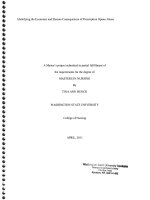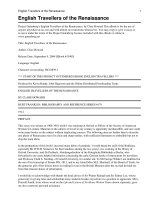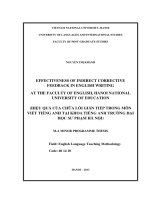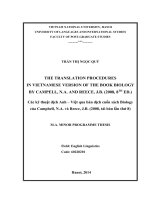Linguistic features in english reviews of the latest high end cameras
Bạn đang xem bản rút gọn của tài liệu. Xem và tải ngay bản đầy đủ của tài liệu tại đây (1.12 MB, 118 trang )
MINISTRY OF EDUCATION AND TRAINING
QUY NHON UNIVERSITY
HÀ BẢO TOÀN
LINGUISTIC FEATURES IN ENGLISH REVIEWS
OF THE LATEST HIGH-END CAMERAS
FIELD: ENGLISH LINGUISTICS
CODE: 8.22.02.01
Supervisor: Assoc. Prof. Dr. NGUYỄN QUANG NGOẠN
BỘ GIÁO DỤC VÀ ĐÀO TẠO
TRƯỜNG ĐẠI HỌC QUY NHƠN
HÀ BẢO TỒN
ĐẶC TRƯNG NGƠN NGỮ TRONG CÁC BÀI ĐÁNH GIÁ
BẰNG TIẾNG ANH VỀ MÁY ẢNH CAO CẤP MỚI NHẤT
NGÀNH: NGÔN NGỮ ANH
MÃ SỐ: 8.22.02.01
Người hướng dẫn: PGS.TS. NGUYỄN QUANG NGOẠN
i
STATEMENT OF AUTHORSHIP
This thesis does not contain any material which has been previously
submitted as a requirement of a degree or diploma at any institution. This thesis
also does not contain any material which has been written or published by other
another person except the reference is made in the text. This work is completely
implemented by myself.
Quy Nhon, 2020
Ha Bao Toan
ii
ACKNOWLEDGEMENTS
This thesis could not have been completed without the support of many
people. I would like to express the deepest respect and appreciation to those
who provide me advice and assistance when I participated in this course,
especially the time when I carried out this research.
First and foremost, I am deeply gratitude to my supervisor, Assoc. Prof.
Dr. Nguyen Quang Ngoan, who has kindly given me advice, useful references
and constant encouragement in this study. Without his guidance and help, this
thesis would not have been complete.
I would like to express my thanks to Mr. Dang Trinh Truong Giang, an
MA student of English Language from the previous course, for his advice and
reference during the time I participated in this course.
I also would love to express my gratefulness to all the lecturers of the
Department of Foreign Languages of Quy Nhon Univesity who have provided
me with precious knowledge in the field of English language.
Last but not least, my love is sent to my parents and my big thanks to my
friends who have back me up through many difficulties during this period so
that I can focus on the thesis and finish it in line.
iii
ABSTRACT
With the explosion of online product reviews in the last two decades,
online reviews are quickly becoming a research trend for linguists to understand
their characteristics. This study aims at investigating 2731 samples of lexical
features and 399 samples of semantic functions in English reviews for the latest
high-end cameras, under five videos of professional reviewers on Youtube.
Both quantitative and qualitative approaches with descriptive, analytic, and
synthetic methods are employed to achieve the targets. Based on the theory of
lexicology of Quirk and Greenbaum (1973) as well as sematic functions of
Lyons (1977) and Leech (1981), the theoretical framework suggests the criteria
for collecting and analyzing the samples. The analysis reveals interesting results
concerning the five word classes (nouns, lexical verbs, adjectives, adverbs, and
modal auxiliaries) contributing the lexicology of English reviews, as well as the
five semantic functions (informing, praising, denoting disappointment,
suggesting, and others) in English camera reviews. To be more specific, nouns,
lexical verbs, and adjectives take a large contribution in review lexicology while
informing, praising, and denoting disappointment are the superior distributions
in semantic functions of English camera reviews. The findings drawn out from
the study make some significant contribution to the teaching and learning of
descriptive language, as well as the people in the field of reviewing product.
iv
TABLE OF CONTENTS
STATEMENT OF AUTHORSHIP..................................................................................I
ACKNOWLEDGEMENTS ............................................................................................ II
ABSTRACT ..................................................................................................................... III
TABLE OF CONTENTS ...............................................................................................IV
LIST OF TABLES .......................................................................................................VIII
LIST OF GRAPHS..........................................................................................................IX
LIST OF ABBREVIATIONS AND CONVENTIONS............................................... X
CHAPTER 1. INTRODUCTION.................................................................................... 1
1.1. RATIONALE ............................................................................................. 1
1.2. AIM AND OBJECTIVES .......................................................................... 2
1.3. RESEARCH QUESTIONS ........................................................................ 2
1.4. SCOPE OF THE STUDY .......................................................................... 3
1.5. SIGNIFICANCE OF THE STUDY ........................................................... 3
1.6. DEFINITION OF TERMS ......................................................................... 4
1.7. ORGANIZATION OF THE STUDY ........................................................ 4
CHAPTER 2. LITERATURE REVIEW AND THEORETICAL BACKGROUND
............................................................................................................................................. 6
2.1. PARTS OF SPEECH .................................................................................. 6
2.2. LANGUAGE FUNCTIONS ...................................................................... 8
2.2.1. Semantic field....................................................................................... 8
2.2.2. Language functions ............................................................................ 10
2.3. LANGUAGE FOR REVIEW................................................................... 13
2.4. REVIEW OF PREVIOUS STUDIES ...................................................... 14
v
2.5. SUMMARY.............................................................................................. 17
CHAPTER 3. RESEARCH METHODOLOGY ......................................................... 18
3.1. RESEARCH DESIGN.............................................................................. 18
3.2. RESEARCH METHODS ......................................................................... 18
3.3. DATA COLLECTION ............................................................................. 19
3.4. DATA ANALYSIS .................................................................................. 21
3.4.1. Analytical frameworks. ...................................................................... 21
3.4.2. Analytical methods ............................................................................ 24
3.5. RELIABILITY AND VALIDITY ........................................................... 24
CHAPTER 4. FINDINGS AND DISCUSSION ......................................................... 26
4.1. LEXICAL FEATURES OF ENGLISH IN CAMERA REVIEWS ......... 26
4.1.1. Nouns ................................................................................................. 28
4.1.1.1. Nouns denoting physical features ................................................ 28
4.1.1.2. Nouns denoting non-physical features ........................................ 29
4.1.1.2.1. Nouns describing specifications and softwares .................... 30
4.1.1.2.2. Nouns describing camera‟s functions ................................... 31
4.1.1.3. Nouns denoting judgments .......................................................... 31
4.1.2. Lexical Verbs ..................................................................................... 32
4.1.2.1. Lexical verbs denoting actions .................................................... 33
4.1.2.2. Lexical verbs denoting emotions ................................................. 34
4.1.2.3. Stative verbs................................................................................. 35
4.1.3. Modal Verbs ....................................................................................... 36
4.1.3.1. Modals denoting possibility and ability ...................................... 36
vi
4.1.3.2. Modals denoting necessity .......................................................... 37
4.1.3.3. Modals denoting prediction and volition..................................... 37
4.1.4. Adjectives ........................................................................................... 38
4.1.4.1. Adjectives describing physical quality ........................................ 39
4.1.4.2. Adjectives describing performance quality ................................. 40
4.1.4.3. Adjectives describing characteristic and judgment ..................... 41
4.1.5. Adverbs .............................................................................................. 42
4.1.5.1. Adverbs of manner ...................................................................... 43
4.1.5.2. Adverbs of degree ........................................................................ 44
4.1.5.3. Adverbs of frequency .................................................................. 44
4.2. SEMANTIC FUNCTIONS OF ENGLISH IN CAMERA REVIEWS ... 45
4.2.1. Informing............................................................................................ 47
4.2.2. Praising ............................................................................................... 49
4.2.3. Denoting disappointment ................................................................... 50
4.2.4. Suggesting .......................................................................................... 51
4.2.4.1. Hearer oriented suggesting .......................................................... 52
4.2.4.2. Company oriented suggesting ..................................................... 53
4.2.5. Other functions ................................................................................... 54
4.2.5.1. Predicting ..................................................................................... 55
4.2.5.2. Warning ....................................................................................... 56
4.2.5.3. Attracting ..................................................................................... 57
4.2.5.4. Questioning .................................................................................. 58
4.2.5.5. Mixed functions ........................................................................... 59
vii
4.3. SUMMARY.............................................................................................. 60
CHAPTER 5. CONCLUSIONS AND IMPLICATIONS .......................................... 61
5.1. CONCLUSIONS ...................................................................................... 61
5.1.1. Lexical features in English reviews of the latest high-end camera ... 62
5.2.2. Semantic functions in English reviews of the latest high-end camera
...................................................................................................................... 63
5.2. IMPLICATIONS ...................................................................................... 64
5.3. LIMITATIONS OF THE STUDY ........................................................... 65
5.4. SUGGESTIONS FOR FURTHER STUDY ............................................ 66
REFERENCES ................................................................................................................ 67
DATA SOURCES ........................................................................................................... 70
APPENDIX ........................................................................................................................ 1
Camera Review 1 – Canon EOS R .................................................................... 1
Camera Review 2 – Nikon Z6 ........................................................................... 6
Camera Review 3 – Sony A7R4 mark IV ....................................................... 13
Camera Review 4 – Fujifilm X-H1 ................................................................. 20
Camera Review 5 – Panasonic S1R ................................................................ 28
viii
LIST OF TABLES
N0
3.1
Tables
Page
Data overview of English reviews for the latest high-end
20
cameras on Youtube
3.2
The Linguistic Category Model proposed by Semin and
22
Fiedler (1991) in the study of Krishnamoorthy (2015)
3.3
Framework for analysis of lexical features in English camera
23
reviews
3.4
Framework for analysis of semantic functions in English
24
camera reviews
4.1
Distribution of lexicology in camera reviews
26
4.2
Semantic function in English camera review
46
ix
LIST OF GRAPHS
N0
4.1
4.2
4.3
4.4
4.5
4.6
Graphs
Percentages of lexicology in English camera reviews
Percentages of sub-nouns in lexicology of English camera
reviews
Percentages of sub-lexical verbs in lexicology of English
camera reviews
Percentages of sub-adjective in lexicology of English camera
reviews
Percentages of sub-adverbs in lexicology of English camera
reviews
Distribution of semantic functions in English camera reviews
Page
27
28
33
39
43
47
x
LIST OF ABBREVIATIONS AND CONVENTIONS
(1):
The first example
[CR1.15]:
Source in appendix: camera review 1, data no.15th
DSLR:
Digital Single-lens reflex cameras
MR:
Mirrorless cameras
1
CHAPTER 1. INTRODUCTION
1.1. RATIONALE
Online reviews for products are becoming a distinction of this era of
digital age due to the combination of the modern technology and the art of
language in use. The reviews contain the information that can provide the
necessary and probably the deeper technical information about the subject.
The approaches to the online reviews are not only fast, but also easier than
ever before. All of that gives the consumer a wider understanding on a
product and also helps them to take a careful decision on buying a product or
not in their circumstances.
Online reviews can be recognized by 2 major types, in written and
spoken reviews. The spoken reviews are the main focus point of this study
due to its versatile combination between the visual videos as evidences and
the presentation of the reviewers to the audiences.
The language of reviews has many linguistic features that have
interested the linguist to explore how effective it is in persuading people to
make decisions. Online-review helpfulness is the major aim of many linguists
(Markus et al., 2015; Laurie et al., 2017; Goele et al., 2017; Hijbul et el.,
2016; Sohail et al., 2016). To achieve that aim, they use the sentimental
analysis on the written language of online reviews collected from many
ordinary reviewers and customers on several famous selling websites. Some
linguists are interested in semantic analysis in online product reviews to
enable helpfulness prediction (Yang et al, 2015) but still mainly focus on the
written type.
2
Due to the gap in the reviews of English spoken language, this study
focuses on the linguistic features, including the lexical features and semantic
functions, of English in reviews for the latest high-end cameras. The
conducting of this work, hopefully to some extent, can cover some of the
linguistic features of the spoken English reviews.
1.2. AIM AND OBJECTIVES
The aim of my research is to study the lexical features and semantic
functions in English that are used in online reviews, especially for the latest
high-end cameras.
In order to achieve the aim of the research, the researcher follows the
objectives:
- To identify and analyze the lexical features in English reviews of the
latest high-end cameras.
- To identify and analyze the semantic functions in English reviews of
the latest high-end cameras.
1.3. RESEARCH QUESTIONS
This thesis focuses on answering the two main questions that can
clarify the objectives:
1. What are the lexical features in English reviews of the latest highend cameras?
2. What are the semantic functions in English reviews of the latest
high-end cameras?
3
1.4. SCOPE OF THE STUDY
This thesis only focuses on the lexical features and the semantic
functions of English in product reviews, specifically the online reviews of the
latest high-end cameras. In the lexical features, the researcher attempts to
study the open class words, in the word level only, for investigating what
kinds of nouns, verbs, adjectives, and adverbs that participate into the English
reviews of the camera. In the sematic field, the researcher attempts to
recognize the functions of the lexical features that are used in the reviews of
the latest high-end cameras.
The researcher performs an investigation in the latest high-end digital
cameras because they are one of the electronic products that own a huge
community and the reviews of the latest high-end cameras can have a huge
influence on the consumer‟s decision. The samples of reviews for the latest
high-end cameras are taken from the high reputation reviewers and in
different camera brands which can give the most diversity of language in
reviews.
1.5. SIGNIFICANCE OF THE STUDY
This research can provide a significant contribution to the knowledge
of lexical features and the semantic function in English reviews. It helps
clarifying the features of lexicology as well as some essential semantic
functions which are embedded in professional English camera reviews. The
findings of the study can help the people in teaching description language and
provide the learner a wider range of vocabulary in the field of electronic
products reviews in general, especially in camera reviews. Plus, English users
can be better of identifying the intentions or indications within the context of
the reports or reviews.
4
1.6. DEFINITION OF TERMS
Camera: a device for taking photographs and/or videos.
Camera review: a report from a reviewer toward the camera features
such as: Photographs and description of camera, detailed specifications,
description of function and operation, timings and performance measures,
image quality measures, competitive camera comparisons, conclusion and
suggestion based on test results and experience with the camera, etc.
High-end camera: The cameras that are on top of the line; referring to
the most sophisticated, and typically the most expensive, product in a line.
1.7. ORGANIZATION OF THE STUDY
The study is organized in five chapters as follows:
Chapter 1, Introduction, gives the rationale, aim and objectives, the
scope, research questions, the definition of term, and the organization of the
study.
Chapter 2, Literature Review and Theoretical background, provides
some of previous studies in the field and the basic concepts, and theoretical
background related to the study.
Chapter 3, Research Methodology, deals with the research methods,
procedures, description of data, data collection, data analysis, and reliability
and validity.
Chapter 4, Findings and Discussion, draws out the results of the
research with the researcher‟s comments
5
Chapter 5, Conclusions and Implications, presents the summary of the
findings and conclusions within the limitation of the study and some
suggestions for further study.
6
CHAPTER 2. LITERATURE REVIEW AND
THEORETICAL BACKGROUND
This chapter concerns the theoretical background and previous studies
that are related to the language of description and semantic functions in
English reviews of the latest high-end cameras.
2.1. PARTS OF SPEECH
Parts of speech are the basic of grammar and they are the most
important units for starting to understand the language. Quirk and Greenbaum
(1973) argue that parts of English speech are units that, when combined, make
up the constituent elements of a sentence. They divide parts of speech into the
system of open-closed classes. They define the closed class items “that they
cannot normally be extended by the creation of additional members” (p.19)
which contain words like: articles, demonstratives, pronouns, prepositions,
conjunctions, and interjections. The open class items comprise nouns, verbs,
adjectives, and adverbs and the definition according to Quirk and Greenbaum
“is indefinitely extendable. New items are constantly being created and no
one could make an inventory of all the nouns in English (for example) and be
confident that it was complete” (p. 19).
However, Quirk and Greenbaum (1973) claim that parts of speech are
sometimes not really clearly distinguished into the open-closed system, like in
the verbs class (lexical verbs and auxiliaries) and adverbs class (adverbs
denoting manner and intensifier adverbs):
Although they have deceptively specific labels, the parts of speech tend in fact to be
rather heterogeneous. The adverb and the verb are perhaps especially mixed
classes, each having small and fairly well-defined groups of closed-system items
alongside the indefinitely large open-class items. So far as the verb is concerned,
7
the closed-system subgroup is known by the well-established term „auxiliary‟. With
the adverb, one may draw the distinction broadly between those in –ly that
correspond to adjectives (complete-ly) and those that do not (now, there, forward,
very, for example) (Quirk & Greenbaum, 1973, p. 20).
Greenbaum in 1996, consolidate the system of open-closed classes by
adding the numeral and auxiliary into the closed class words.
Quirk et al (1985) claim that modal verbs can be divided into two types
of modality meaning:
(a) Those such as 'permission', 'obligation', and 'volition' which involve some kind
of intrinsic human control over events, and
(b) Those such as 'possibility', 'necessity', and 'prediction', which do not primarily
involve human control of events, but do typically involve human judgment of
what is or is not likely to happen.
These two kinds, between which there is a gradient, may be termed INTRINSIC
and EXTRINSIC modality respectively. One important observation about the
modals is that each one of them has both intrinsic and extrinsic uses: for example,
may has the meaning of permission (intrinsic) and the meaning of possibility
(extrinsic); will has the meaning of volition (intrinsic) and the meaning of
prediction (extrinsic) (Quirk et al, 1985, p. 219).
Quirk et al (1985) also notice that “there are areas of overlap and
neutrality between the intrinsic and extrinsic sense of a modal” and “the
modals themselves tend to have overlapping meanings, such that in some
circumstances, they can be more or less interchangeable” (pp. 219-220).
This thesis only focuses on is the open classes items (known as the
lexical words or content words) rather than the closed class items
(grammatical words) due to the fact that the open class words can be
expanded by compounding words and thus used to describe. However, the
modal auxiliaries and the intensifier adverbs (intensify for degree, frequency),
belong to the closed class words, but contain characteristics of describing
mood and information intensity, so they are noticed in the analysis process.
8
2.2. LANGUAGE FUNCTIONS
2.2.1. Semantic field
The study of semantic theory has been synthesized and developed by
many famous linguists, especially Lyons, with the influence of Semantics:
Volume I and II. Lyons (1977) believes that the theory of semantic field is
initially introduced by various German and Swiss scholars in 1920s and
1930s, but he also claims its historical root “can be traced back at least to the
middle of the nineteenth century and, in a more general way, to the ideas of
Humboldt (1836) and Herder (1772)” (Lyons, 1977, p. 250).
Gao and Xu (2013) synthesize many linguists‟s definitions of semantic
field:
“semantic fields”, that is, groups of words of which meanings are closely
interrelated. Originally, “field” is a concept applied in physics which describes the
layout condition of a certain object, such as electric field, magnetic field and
gravitational field, which separately shows the layout principles of electricity,
magnesium and gravity in a certain space. This concept was later applied into
linguistics to describe the inter-relationship between different words. Gradually, it
turned into a new linguistic approach called semantic field theory (Gao and Xu,
2013, p.2030).
Brinton and Brinton (2010) summarize Lyons's recognition of three
major types of semantic field (synonymy, hyponymy, and oppositeness) in her
book of the linguistic structure of modern English for more concise and
accessible to the reader.
The concept of synonymy follows Brinton and Brinton (2010), in short,
is “well-known and intuitively obvious; it denotes sameness in meaning, or
sense” (Brinton, 2010, p. 150). Some examples of synonymy in words can
be: unhappy/sad; huge/enormous; correct/right; etc. Synonymy is contextdependent as two words can share the same meaning in some specific
9
situation, but not exactly in other cases. Pale/light is a pair of word which are
synonymy in “The shirt is pale/light in color” but in “the book is light (pale is
incompatible) in weight”. Synonymy ignores the connotations of words and
recognizes only their denotations as in horse/steed/nag. Synonyms may also
differ in degree or intensity, as in rain/showers/sprinkles/downpour. Brinton
also regards the aspects of stylistic ignores in synonymy in several terms like
social or geographic dialect distribution, etc such as cookie (in U.S) and
biscuit (in U.K).
Brinton and Brinton (2010) describe Lyons‟s (1977) hyponymy “is a
relation of inclusion or entailment”. There are two terms in the relation of
hyponymy: the superordinate term include the hyponyms (or cohyponmys in
Lyon‟s term). The meaning of hyponyms (such as: sparrow, eagle, hawk, etc)
entails the meaning of the superordinate (like: bird, animal); however, this
only occurs in one way, I bought a sparrow means I bought a bird or I bought
an animal, but I bought a bird or I bought an animal does not entail I bought
a sparrow. The mentioned examples also illustrates a hierarchy of animal
hyponyms, which sparrow entails bird, bird entails animal.
In the relationships of oppositeness introduced by Lyons (1977),
Brinton and Brinton (2010) categorizes in three relations: complementarity,
antonymy, and converseness. They define the complementarity “is a relation
of contradiction, in which the denial of one term is the assertion of its
complementary term. X is not Y and Y is not X” (Brinton and Brinton, 2010,
p. 152). Some typical pairs of complementarity are: dead/alive, pass/fail, rawcooked, legal/illegal, etc. The antonymy, however, points to the gradable
values, which may be compared in an obviously or obscurely way. Some can
be name: fat/fit/thin, hot/warm/cool/cold/freeze, small/average/big/large, etc.
The converseness refers to a terms of words that can be reversal. For example,
10
Susan bought the car from Tim entails and is entailed by Tim sold the car to
Susan. A special kind of converseness that Brinton mentions to is called
symmetry, which it is possible when said in both ways: Helen is married to
David and David is married to Helen.
The theory of semantic field shows that words belong to the same
semantic field are abundant. They can share the same idea of the speaker,
using either their denotations or connotation. Thus, identifying the semantic
meaning of words is an essential step for a full knowledge of the relevant field
as well as a stepping stone for understanding the deliver‟s intentions.
2.2.2. Language functions
Language is used to convey meaning of the speaker; identifying the
meaning of the language can help the listener to perceive and respond
correctly. Every time making an utterance, we all carry out a purpose. It could
use to express feelings, to ask for help, to give advice, etc. In short, they carry
a message or an emotion. All these purposes of language which we could use
fall into five language functions of Leech‟s realization (1981): informational
function, expressive function, directive function, aesthetic function, and
phatic function.
The informational function is “neutral” and “most important” (Leech,
1981, p.40). This function concentrates on the message since it helps people
to deliver message, to describe things, to provide new information to other
people.
Expressive function “can be used to express its originator‟s feelings
and attitudes – swear words and exclamations are the most obvious instances
of this” (Leech, 1981, p.40). Indifferent with the informational function, the
expressive does not deliver any particular information toward the hearer but it
11
aims to express the speaker‟s attitude or feelings that could be positive or
negative. The usage of the expressive function of language can provide the
speaker‟s personality, thus enable a strategy to be responded to the hearer. An
example of expressive function is when we said “The cat is adorable”, we do
not give the listener any particular information about the cat, but our feelings
about it.
The directive function of language is used to trigger certain actions or
reactions toward the hearer. This function expresses the meaning of social
control and interpersonal interaction. Commanding and requesting are the two
prominent features of this function as they influence the hearer‟s behavior or
attitudes rather than the speaker‟s thought since the hearer‟s reaction
determines whether the commanding or requesting achieves the target or not.
Aesthetic function is the fourth function of language which is “the use
of language for the sake of the linguistic artifact itself, and for no purpose.
This aesthetic function can have at least as much to do with conceptual as
with affective meaning” (Leech, 1981, p.41). The function of aesthetic does
not contain any particular purpose, neither perform as a request nor a
message, except a tool of poetic art. As such, the beauty or the artistic of
words and phrase are more important than the precise of the information.
The fifth function of language is the phatic function. Leech (1981)
defines it as a function to maintain social relationship:
The function of keeping communication lines open, and keeping social
relationships in good repair (in British culture, talking about the weather is a wellknown example of this). The phatic function is at the furthest remove from the
aesthetic function, in that here the communicative work done by language is at its
lightest: it is not so much what one says, but the fact that one says it at all, that
matters” (Leech, 1981, p. 41).
12
As such, the phatic function is used to begin or continue the
conversation. The example of Leech about the British‟s culture of talking
about the weather that shows this kind of talk does not provide any value and
necessary information but to open a conversation. The conversation serves
only for helping people to interact to others. In some cases, such
conversations may contain some highlight information, but it is not the
primary concern or necessary.
Although the five functions of the language are proposed by Leech
(1981), he also claims that those functions are not an ideal classification. In
fact, in reality, a number of different functions can be found in a sentence and
„rarely is a piece of language purely informative, purely expressive, etc”
(Leech, 1981, p.41). A remark such as “I feel like a cup of tea”, in some
circumstances, it can have multiple functions such as: an informational
function which could provide the status of the speaker, an expressive function
which could express his feeling, a directive functions which could indirectly
asking another for a cup of tea.
In order to identify the language functions, Leech also mentions the
five essential features in communicative situations, namely: subject-matter,
originator (speaker or writer), receiver (hear or reader), the channel of
communication between them, and the linguistic message itself. The five
essential features in communicative situations, in some extent, are similar to
the term “context” and “co-text” which Yule (1997) suggests. Yule (1997)
argues that context is the physical environment that contains participants,
locations, times, and other physical aspects; while co-text is the linguistic
material concerning the linguistic patterns that introducing and/or succeeding
an analyzed utterance.
13
As mentioned above, analyzing semantic functions in a specific context
must take into account the speaker‟s situation to clarify his meanings; in that
case, a language function is no longer the solo semantic function, but a
pragmatic function of some kind.
2.3. LANGUAGE FOR REVIEW
With the development of multimedia, especially the internet, it is not
difficult for everyone to approach a review of goods, products, or equipment.
Understanding high-end products is a matter of concern to consumers in these
days as knowledge of product plays a role in determining consumer spending.
Product reviews therefore serve as a bridge between consumers and
purchasing decisions. However, a review must perform well with honesty,
impartiality in product strengths and weaknesses, in order to attract viewers
and empower reviewers. Language for review, in some way, tends to share
some common terms with the language of criticism which Casey (1966)
points out to the extent that there is a relation between description and
evaluation in terms of values.
Language for description is widely introduced by some linguists, Kane
(2000, p.352) defines that “description is about sensory experience how
something looks, sounds, tastes. Mostly is about visual experience, but
description also deals with other kinds of perception”. The social function of
descriptive language is to describe a particular person, place or thing. Gerot
and Wignell (1994, p.208) propose the generic structure of descriptive
language to cover: first, “identification which identifies phenomenon that will
be described” and second, “the description which describe parts, qualities, or
characteristics of something or someone in detail”. In addition, Knapp and









